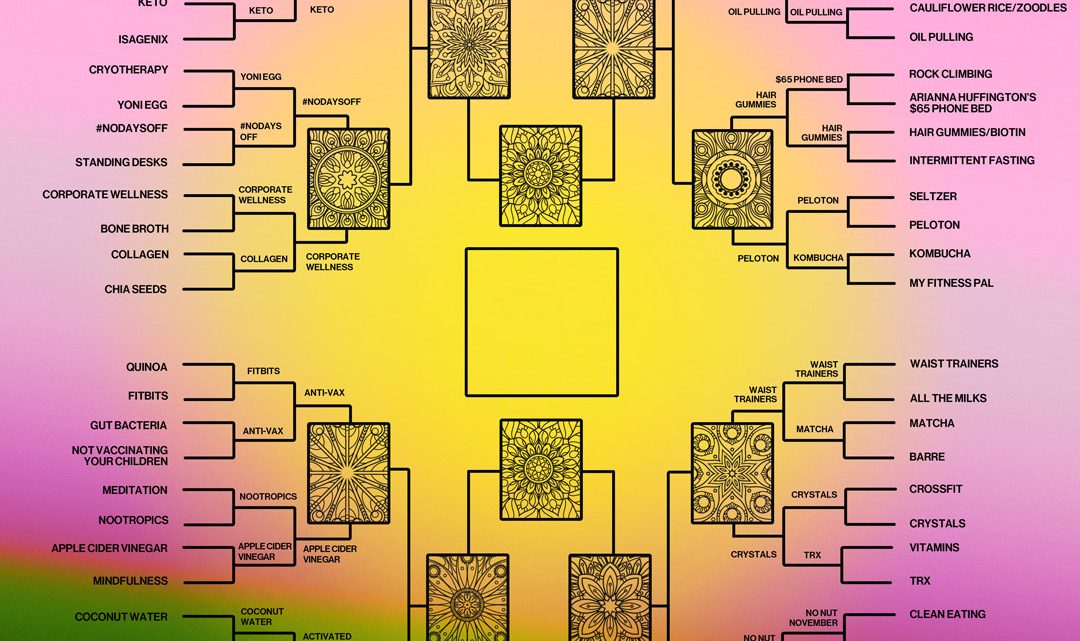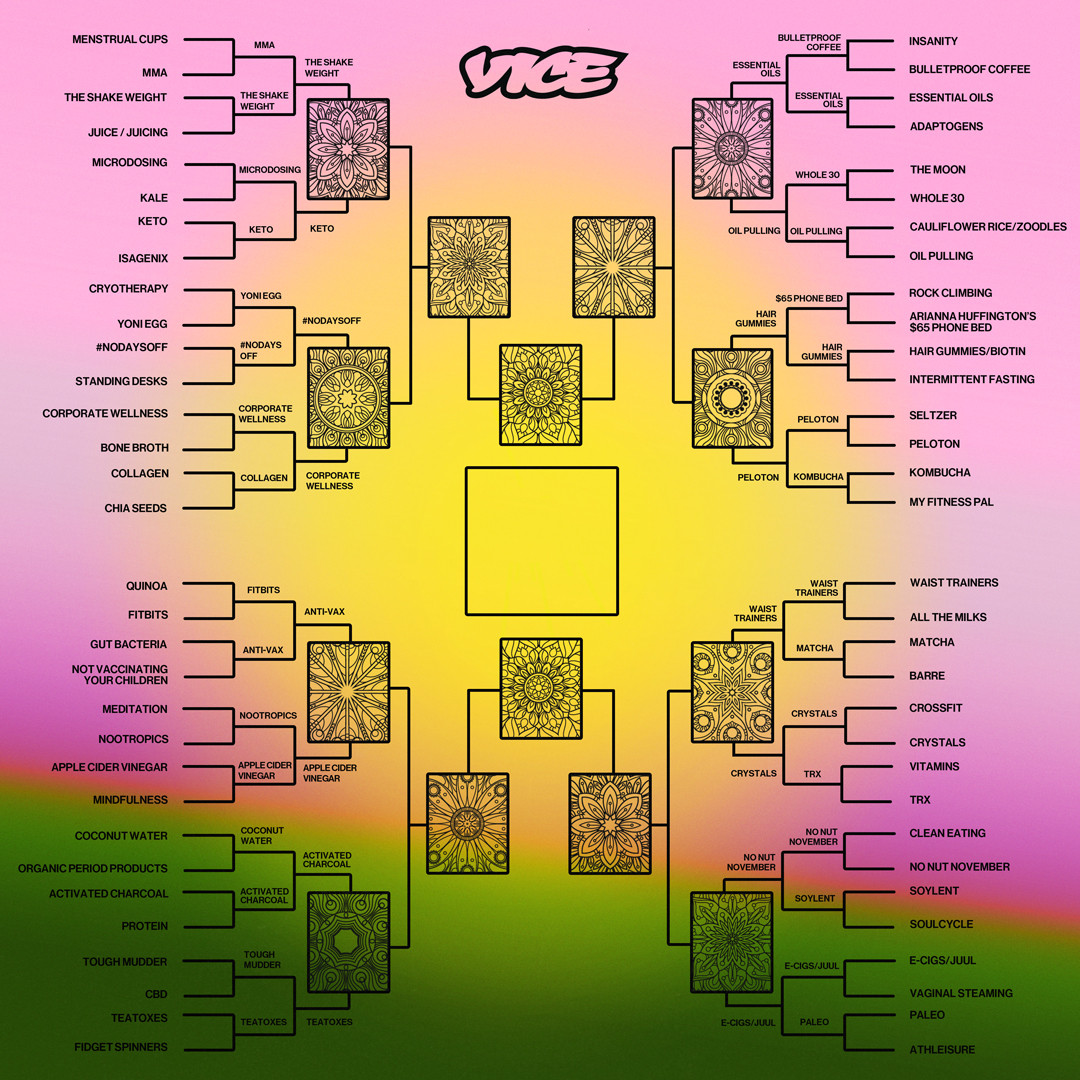
Round 3: What Was the Worst Wellness Trend of the 2010s?
December 19, 2019Welcome back, wellness connoisseurs, and thanks again for playing along as we determine the Worst Wellness Trend of the 2010s. We’ve already worked our way through some of the decade’s most ridiculous health fads. With Round 2 wrapped up, some strong contenders are newly out of commission: RIP Yoni egg—we’ll miss you so much—and we’re frankly aghast at the fact that keto swiped the lead from microdosing, but the people have spoken! Now that we’ve whittled it down to 16 of the wildest, Round 3 is about to get serious. Let us know how you feel by voting (or tweeting at the corporate account, if you must) as we race towards the finish line—we’re crowning the winner tomorrow!
In the meantime, let’s cinch up our waist trainers and strap in for the ride. Read on for your picks so far for the worst, most annoying, most destructive wellness trend of the decade, and help us zero in on a winner. And be sure to tune in tomorrow (you can check this post or our Twitter) for all the final rounds!

Matchup 1
The Shake Weight—The Shake Weight, a dumbbell that shifts around as you essentially jerk it off, was invented to capitalize on a nationwide fixation on Michelle Obama's toned arms. More than two million of them were reportedly sold after the 2010 debut of a lurid advertisement—in which women demonstrated how to use the device (again, by giving it a vigorous handjob)—that went viral.
Keto— Keto, or the “ketogenic diet,” is a high-fat, low-carb meal plan designed to send the body into a state called “ketosis” and burn up stored fat; it spiked in popularity around 2017. Studies have shown it has benefits for people looking to control neurological disorders like epilepsy. Otherwise, it’s potentially bad for your brain because it deprives it of the glucose it needs to run smoothly. Plus, it’s notoriously hard to sustain. Have you ever gone out to eat while doing keto? It’s almost as bad as going out to eat with someone who’s doing keto.
Matchup 2
#nodaysoff—Because of our deep aversion to loving ourselves, we closed the decade bragging about #grinding, #nevernotworking, and taking #nodaysoff from our jobs on social media. Come on, bb, let’s get that bread and that engagement! It’s not like the labor movement of the late 19th and early 20th century worked tirelessly to get us weekends, paid time off, the 40-hour week, and other necessary reprieves from capitalism’s clutches or anything!
Corporate wellness—Corporate wellness is the latest iteration of workplace wellness, which has been around since the late 1800s, and has always existed to increase worker productivity. The current iteration of corporate wellness is mainly focused on mindfulness, but can also include, uh, taking DNA samples from employees or harassing a double-mastectomy patient into getting a mammogram. Surprisingly, these programs don’t actually contribute to workplace wellness. Go figure!
Matchup 3
Not vaccinating your children—Being anti-vax is extremely stupid and actively harmful, and is the rare value shared by extremely wealthy liberalsand Republicans. People who neglect to vaccinate their kids mostly do so because they’re worried about disproven side effects like autism. Vaccines are so soundly safe and medically advisable, that not believing in them is like thinking chemtrails are what happen when angels fart.
Apple cider vinegar—Instagram loves apple cider vinegar, which is supposed to be something of a cure-all: ACV will solve indigestion! Get rid of dandruff! Take care of a sore throat, reflux, and eczema! People use it topically for skin and hair issues, and take shots of it (diluted with water, one hopes) for digestive and other internal issues. There is no evidence it has any health benefits whatsoever, unless you're eating a salad underneath it—it makes for delicious dressing.
Matchup 4
Activated charcoal—While it has long proven effective at treating overdoses and improving digestion, activated charcoal got a cute new wellness makeover during the 2010s, popping up in everything from toothpaste to ice cream by mid-decade, largely thanks to its super Instagrammable, rich black color. Unfortunately, putting activated charcoal in something like ice cream has, if anything, a detrimental effect, sucking the calcium, potassium, and other vitamins right out of the frozen dairy treat before your stomach can absorb them.
Teatoxes—In the early 2010s, there was an explosion of “fit teas” with names like Bootea, Skinny Me Tea, and Flat Tummy Tea. Despite seeming to come out of nowhere, the brands apparently had big enough #sponcon budgets to get into the hands of influencers and A-list celebrities who shamelessly promoted them on Instagram. The teas promised to help you “feel light” or “fight bloat”... thanks to the help of senna, an FDA-approved ingredient that is essentially a laxative. In reality, they either did nothing or made you shit your brains out.
Matchup 5
Essential oils— Scented, plant-derived oils surged in popularity around 2017, in part thanks to wellness conspiracists like InfoWars' Alex Jones and Goop's Gwyneth Paltrow, who marketed their purported health benefits to their followers. Multi-level marketing companies like doTerra and Young Living also popped on Facebook, where distributors push them to their friends, claiming they can cure… just about anything a person might like for them to. Medical science points out that they're possibly good for aromatherapy—but that you might want to also try actual medicine for what ails you instead of what amounts to homeopathic perfume.
Oil pulling—Oil pulling, or swishing an oil around one’s teeth for 10-20 minutes at a time, comes from a time before we had anything resembling modern dentistry. Yet in 2014, everyone started talking about it. Then everyone realized it was gross, time consuming, and didn’t replace regular brushing. Ah, well.
Matchup 6
Hair gummies—Thanks to the pioneering efforts of The Bachelor’s most shameless castoffs in the mid-2010s, the world got sold on the idea that a blue pastel gummy bear could maybe give us luxurious locks. But do hair growth gummies really work? Publications have been asking that question since at least as far back as 2015, and, despite the completely static scientific evidence about biotin’s ability to strengthen brittle nails and make hair grow thicker and faster (it’s insufficient, babes!), they always come to the same conclusion: We should write a blog about it and “find out.” Meanwhile, in 2019, influencer overlords James Charles and Tati Westbrook almost murdered each other over SugarBearHair promo. As Natasha from America’s Next Top Model Cycle 8 would say, some people have war in their countries!
Peloton—A Peloton is a $2,200+ exercise bike with a screen attached that allows riders to stream Peloton workout classes ($39/month), from the comfort of their beautifully sparse Black Mirror-esque homes. The brand—which is beloved by celebrities like Hugh Jackman and other unknown Rich People—was founded in 2012 and has been “ selling happiness” (again, for $2,245 + $39/month) ever since. If you are looking for a vaguely culty bougie fitness trend to get into, but can’t afford to buy a Peloton for yourself, there’s always the possibility that Hubby will gift you one.
Matchup 7
Waist trainers—"Who doesn't love to feel tight & right?!?" wrote Khloe Kardashian in a 2014 Instagram caption underneath a photo of herself in what appeared to be a tight black corset. She and her sisters Kim and Kourtney proceeded to wallpaper the internet with photos of themselves wearing waist trainers, often while working out. The compressive abdominal sleeves squinch their wearers' stomachs restrictively, supposedly to target fat loss around that area and help you sweat more. This has no basis in science, and is actually mad dangerous, no matter how "tight and right" they purport to make their wearers feel in a gym selfie.
Crystals—Crystals are gorgeous rocks that believers say harness energy, which can then be used to heal, to attract, and to manifest (or, at least, look nice on a table). The trend apparently sprang out of an uptick in interest in quartz jewelry around 2007, and gained traction throughout the decade. We’re still in the thick of it, even though crystal mining is deeply unethicaland environmentally unsound. At least it’s also proven pseudoscience!
Matchup 8
No Fap/No Nut November—No Nut November is a trend rooted in mens’ proclivity toward doing stupid shit that harms only themselves for no reason and/or for reasons rooted in deeply held misogyny. The Reddit-based challenge involves simply… not orgasming for a month, despite this having no health benefit or implication at all.
e-cigs/juul—The rapid glow-up (and even-more-rapid fall) of e-cigs and vapes was pretty incredible. At the beginning of the decade, e-cigs were cumbersome contraptions that earned their users a fair amount of bullying; cut to 2018, and everyone (including teens) could be found sucking on their JUULs. The decade comes to a close with vaping’s safety in serious question.
What Was the Worst Wellness Trend of the 2010s?
Round 2: What Was the Worst Wellness Trend of the 2010s?
Sign up for our newsletter to get the best of VICE delivered to your inbox daily.


